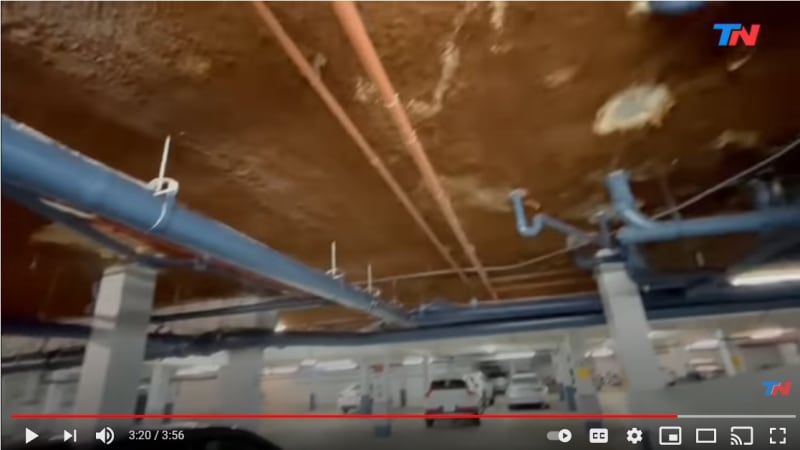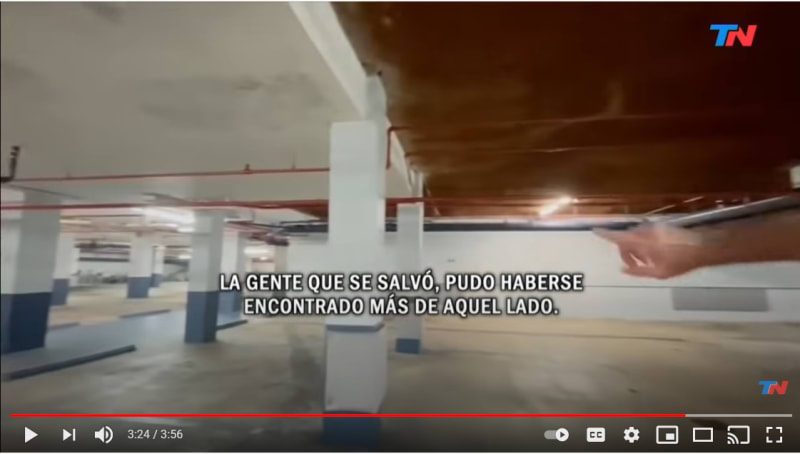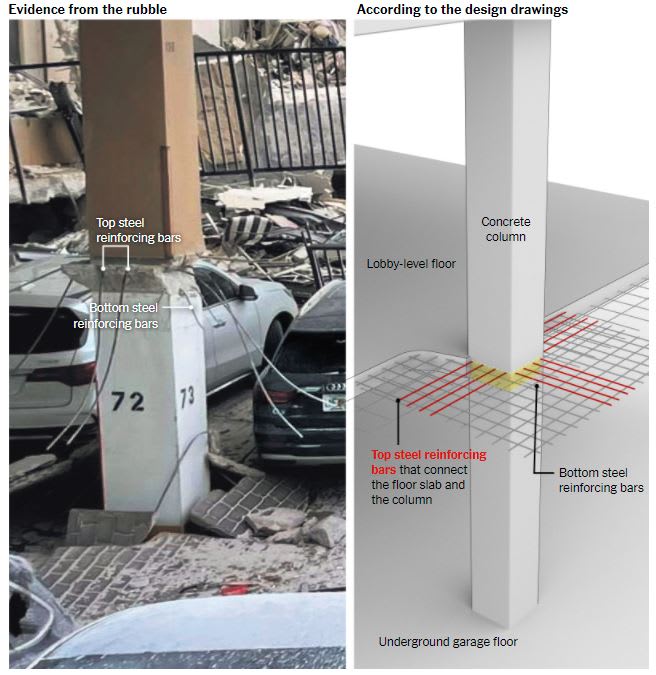The subtitles in the video are more accurate than the auto generated ones. This is a quick and dirty as many who don't understand Spanish may find the video more interesting with a better translation.
00:21 Estamos en el edificio gemelo, pero aquí
[We are in the twin building, but here]
00:24 uno llega con el auto ingresando por
[one would arrive by car entering from]
00:25 Collins en rumbo hacia el norte y tenía
[Collins going north and you had to]
00:29 que dejar el auto aquí.
[leave the car here.]
00:31 Miren qué bien que se ve. Parece muy
[Look how good it looks. It seems very]
00:34 seguro, muy bien mantenido.
[safe, very well maintained.]
00:38 Ahora estamos subiendo por la escalera que (se) colapsó.
[Now we are going up the staircase that collapsed.]
00:41 Esta es la parte que dá a la playa.
[This is the door that leads to the beach.]
(Music)
00:50 Estas son las puertas de ingreso a los
[These are the entry doors to the]
00:54 departamentos que (se) colapsaron.
[apartments that collapsed.]
00:58 Esta parte que es la puerta de ingreso a tu
[This part which is the entry door to your]
01:00 departamento, ¿Hubiera quedado en pié?
[apartment, would it have stayed upright?]
01:02 Sí, esta parte sí. este departamento, este creo que se hubiese
[Yes, this part yes. This apartment, this one I think would have]
01:05 cortado por la mitad.
[been cut in half.]
01:09 ¿Víste que se vé entre los balcones,
[Can you see that you can see between the balconies]
01:11 cómo que la parte del edificio se vé abierta?
[how that part of the building looks open?]
01:12 Yo creo que es este departamento,
[I think it is this apartment,]
01:13 las habitaciones de este departamento
[the rooms of this apartment]
01:15 Creo que acá el techo te da un poco la idea de done se corta la...
[I think here the roof gives you a little bit the idea of where the..]
01:17 El muro de corte. O sea que si
[The plane of the cut. In other words, if]
01:21 estuviéramos en el otro departamento, a
[we were in the other apartment, from]
01:22 partir de esta línea, dando un paso más
[this line on, taking one more step]
01:25 hacia allá, ya no habría nada, sólo el mar.
[over there, there would be nothing, only the ocean.]
01:29 Estaríamos viendo la montaña de escombros.
[We would be looking at the mountain of rubble.]
01:33 (Music)
01:38 Así eran los balcones
[This is what the balconies were like]
01:40 del edificio colapsado porque es el
[of the collapsed building because it is]
01:43 mismo diseño arquitectónico, la misma
[the same architectural design, the same]
01:45 empresa, el mismo estilo.
[builder, the same style.]
01:49 Para que vean ustedes, cuando ven ese
[So you can see, when you see that]
01:53 colapso progresivo
[progressive collapse]
01:55 cómo los balcones se fueron apilando, uno
[how the balconies stacked themselves, one]
01:59 arriba del otro.
[on top of the other.]
02:01 ¿No hay nadie en el edificio ahora?
[Is there anybody in the building now?]
02:03 Hay muy poca gente. Cómo te habrás
[There are very few people. As you may have]
02:04 dado cuenta, el 80% del edificio
[noticed, 80% of the building]
02:09 se exilió por voluntad propia.
[left on their own.]
02:10 (Sound cuts out so no transcript)
02:19 Las personas que decidieron tomar esta vía
[The people that decided to take this route]
02:23 y llegar hasta esta puerta de emergencia
[and got to this emergency door]
02:25 que estamos mostrando ahora,
[that we are showing now,]
02:27 son las que pudieron salvarse,
[are those that were able to save themselves.]
02:31 son las que pudieron ser rescatadas.
[are those that were able to be rescued.]
02:41 Si estuvieramos en el edificio que (se) colapsó,
[If we were in the building that collapsed,]
02:42 esta sería la primera parte que (se) colapsó,
[this would be the first part that collapsed.]
02:44 (Sound begins again.)
02:45 porque es la (parte) de la plataforma de la piscina
[because it is the part of the pool deck]
02:47 y abajo de la piscina está

, los, los gara...
[and beneath the pool are, the, the gara...]
02:49 el, el, ...
[the, the]
02:52 lo que sería el sector de estacionamiento.
[what would be the parking area.]
02:54 (Music)
[]
02:56 ¿A cuánto estamos Alan aquí?
[How far away are we here, Alan?]
02:58 A una cuadra. (can't understand)
[One block away]
02:59 Un bloque digamos: 160 metros
[A block let's say: 160 meters]
03:02 aproximadamente.
[approximately.]
03:05 (Music)
03:07 En el edificio colapsado es todo esto es
[In the collapsed building all this is]
03:10 lo que falta.
[what is missing.]
03:11 [Música]
03:19 La gente que se salvó, pudo haberse encontrado
[The people that save themselves, could have been]
03:23 más de aquel lado.
[more towards that side.]
03:25 Acá arriba está la pileta está la pileta.
[Up above here is the hot tub(?).]
03:28 Y acá dicen que también perdía mucha agua.
[And here they say that it also would leak a lot.]
03:30 Pero este edificio parecería estar
[But this building would seem to be]
03:31 mejor mantenido de lo que
[better maintained that what]
03:33 mostraron en el otro edificio.
[what was shown of the other building.]
03:35 La verdad, pero bueno, es similar.
[The truth, for what it's worth, it's similar.]



